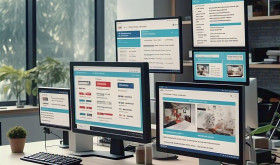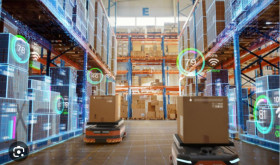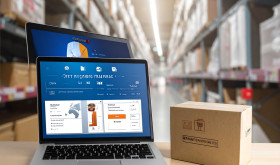
In 2025, supply chains face big challenges, like global shipping problems, not enough workers, and pressure to be eco-friendly. Warehouse Management Systems have become a keyway to solve these issues. They help businesses run better, work smarter, and stay strong when things change. This article looks at how Warehouse Management System tackles current supply chain problems and gives useful tips on how to make the most of what it can do.
Current Supply Chain Challenges
The world of shipping and logistics deals with several big problems that affect how warehouses work:
- Labour Shortages: Businesses now depend more on temp workers and struggle to keep skilled employees leading to less efficient operations.
- Inventory Volatility: Unexpected changes in demand and problems in the supply chain have made it harder to manage inventory.
- Sustainability Mandates: Companies face pressure to cut their carbon output while keeping operations cost-effective.
- Cybersecurity Risks: As systems become more connected, warehouses are now more open to cyber-attacks, which could harm data and stop operations.
The Role of Warehouse Management Systems
Today’s Warehouse Management System platforms are built to face these issues head-on by combining cutting-edge tech like AI, robotics, and real-time analytics. Here’s how Warehouse Management System tackles supply chain problems:
- Labour Optimisation
Warehouses struggle with labour shortages as customers want faster order fulfilment. Warehouse Management System helps by:
- Using robots to do repetitive jobs like picking, packing, and sorting.
- Predicting how many workers are needed based on past data and current trends.
- Using AI to assign tasks considering where workers are, what they’re good at, and how much work they already have.
These features cut down on the need for manual work and boost staff morale by creating a safer and more organised workplace.
- Inventory Management Amid Volatility
Inventory ups and downs have become a big issue due to changing consumer demand and supply chain problems. Warehouse Management System tackles this through:
- Real-Time Visibility: RFID tags and IoT sensors give quick updates on stock levels in different places.
- Demand Forecasting: AI-driven analytics predict how much inventory is needed based on past trends and market changes.
- Dynamic Stock Allocation: Smart systems optimize where to store items to ensure efficient picking routes and avoid running out of stock or having too much.
These features allow businesses to use flexible inventory strategies that balance keeping customers happy with keeping costs down.
- Sustainability Integration
Sustainability is now a must; laws require companies to track emissions and use greener methods. Warehouse Management System helps meet sustainability goals by:
- Suggesting green storage layouts to cut down energy use.
- Working with transport management systems to find the best delivery routes and save fuel.
- Streamlining tasks to reduce waste through exact inventory tracking and expiration control.
By using these tools, businesses can reach their sustainability goals while staying profitable.
- Better Cybersecurity
As warehouses go digital, cybersecurity risks grow. A strong Warehouse Management System protects against these threats by:
- Rolling out encryption protocols to secure data as it moves across connected systems.
- Offering real-time monitoring tools to spot unusual system behaviour.
- Making sure new data privacy rules are followed through automated document management.
These steps guard private info while keeping operations running during cyber-attacks.
Technological Trends in Warehouse Management System for 2025
Several new technologies are changing how warehouse management systems will work in 2025:
- AI-Driven Optimisation
AI-powered Warehouse Management System platforms have an influence on inventory management by examining large data sets to forecast stock requirements, enhance storage distribution, and boost picking efficiency. These systems also improve the accuracy of demand predictions, which leads to fewer out-of-stock situations and better overall performance.
- Autonomous Robotics Integration
Companies employ robots to automate routine jobs such as sorting and packing. Up-to-date Warehouse Management System platforms work with robotic systems, which increases productivity and cuts down on labour expenses.
- 5G Connectivity and Edge Computing
The launch of 5G networks makes it possible for IoT devices, robots, and Warehouse Management System platforms to communicate with each other . Edge computing handles data near where it comes from, which cuts down delays and helps make decisions quicker.
- Cloud-Based Solutions
Warehouse Management System solutions that run in the cloud can grow with your business, cost less to start, and work well with other systems like Transport Management System or ERP platforms. You can use these solutions from anywhere, and they support your business as it expands.
Case Study: Using Warehouse Management System to Build Resilience
A big electronics company worldwide struggled with unpredictable inventory because of chip shortages in 2024. They started using an AI-powered Warehouse Management System with real-time data tools:
- The company cut stockouts by 30% by predicting what customers would want.
- Automatic processes made picking 25% more efficient, which helped fill orders faster when things got busy.
- Features that save energy reduced warehouse power use by 18%, which lined up with what the rules said they should do.
This case shows how using advanced Warehouse Management System can transform warehouses into resilient hubs within the supply chain ecosystem.
To wrap up: Looking ahead to the Future of Warehousing
Warehouse Management Systems now do more than just run operations—they help companies tackle big supply chain problems. These systems make the best use of workers, keep data safe, and let businesses handle ups and downs while staying ahead in a fast-changing market.
As new tech like AI, robots, and 5G change how logistics work, companies need to focus on getting the right Warehouse Management System for their needs. This helps them work better, make customers happier, and build supply chains that last long into the future.
Now’s the time to get top-notch warehouse management systems. Companies that do this will do well, while those that wait might fall behind in an increasingly dynamic global economy.










